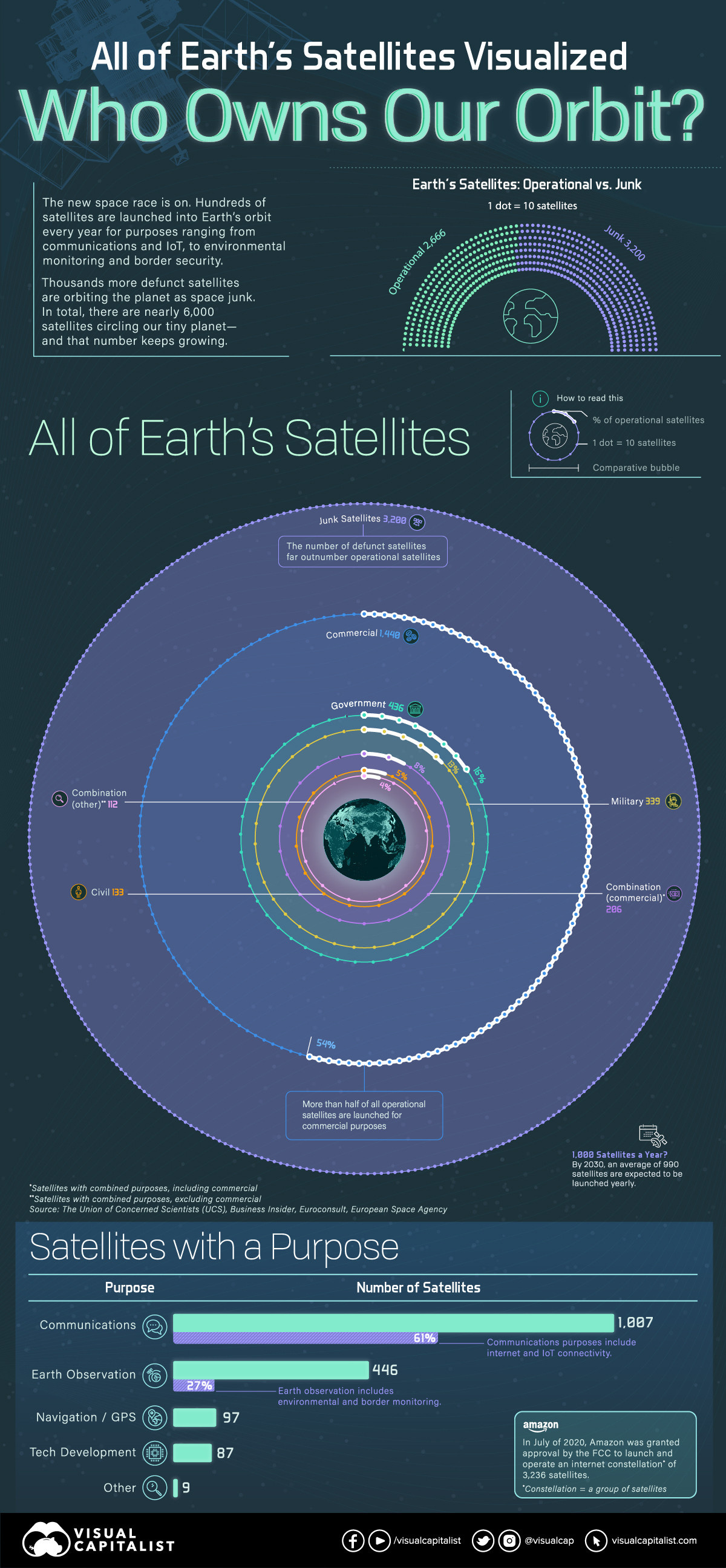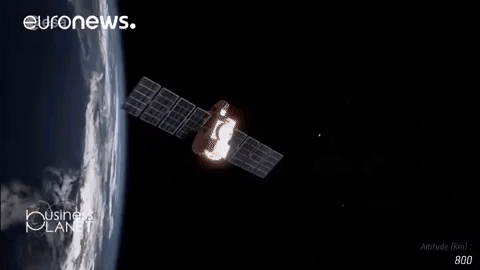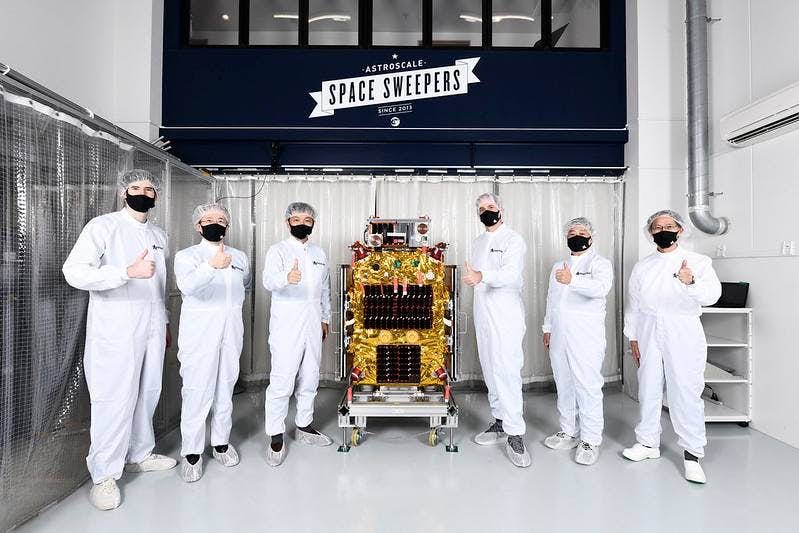Year 2049 is the weekly newsletter that discusses the impactful innovations and discoveries shaping our future.
If this was forwarded to you, subscribe for free to get a new story in your inbox every Friday.
Today’s Edition
Comic: Vic and Tori try to clean up space debris
Story: The space junk problem and the startups trying to solve it
Bonus: A visualization of all the satellites in space
This week’s comic
The backstory
Space needs some heavy cleaning
Space needs as much cleanup as a movie theatre after a 2.5-hour horror movie.
Ever since we started venturing into space, we’ve left countless debris from decommissioned satellites and parts of spacecraft that remain in low Earth orbit for decades.
A 2021 report from NASA found that millions of pieces of debris are orbiting Earth as we speak:
26,000+ pieces of debris the size of a softball or larger that could destroy a satellite on impact.
500,000+ pieces of debris the size of a marble big enough to cause damage to spacecraft or satellites.
100 million+ pieces of debris the size of a grain of salt that could puncture a spacesuit.
The problem, NASA says, is that governments and space programs have not done a good job of cleaning up after themselves once their missions are done.
The Inter-Agency Space Debris Coordination Committee recommends bringing down defunct satellites no later than 25 years after decommissions. NASA’s study found that the global compliance rate for this has averaged between 20% to 30%, much lower than the recommended 90%.
Imagine how dangerous sailing the high seas would be if all the ships ever lost in history were still drifting on top of the water.
– ESA Director General Jan Woerner, in a press release
The risks of debris in space
Although space is vast, orbital debris travel at ~25,000 kph (15,700 mph) so the impact of the smallest piece of debris can be extremely damaging and dangerous. Some risks include:
Colliding with satellites and spacecraft which can damage or destroy them while creating even more debris. The International Space Station (ISS) performs maneuvers to avoid space debris (NASA).
Putting astronauts at risk of getting their spacesuit punctured. If you’ve watched any space movie, you know that’s bad.
Interfering with space-based applications such as weather forecasting, GPS, and telecommunication.
Some scientists fear the Kessler Syndrome, a phenomenon in which the amount of junk in orbit around Earth reaches a point where it just creates more and more space debris through continuous collisions.
How to fix the space junk problem

According to NASA, solving the space junk problem requires both mitigation and strategic remediation:
Mitigation: How can we prevent the creation of orbital debris?
→ By avoiding the destruction of dead satellites (some countries destroy their dead satellites) and removing decommissioned satellites within 25 years.
Remediation: How can we remove existing debris from space?
→ By using new technological solutions that can capture and remove debris from low Earth orbit.
The companies that want to clean up space
ClearSpace
Founded: 2018
Funding: $5 million raised + $98 million provided by ESA for the ClearSpace-1 mission
Location: Lausanne, Switzerland 🇨🇭
Mission: ClearSpace has been selected by the European Space Agency (ESA) to lead the first space debris removal mission to capture a piece of a Vega rocket that was left in 2013. The mission, called ClearSpace-1, is set to launch in 2025.
Technology: Spacecraft with four robotic arms to capture debris and drag it into Earth’s atmosphere (so it can burn upon re-entry).
Astroscale
Founded: 2013
Funding: $204 million
Location: Tokyo, Japan 🇯🇵
Mission: In 2021, Astroscale launched their first test mission, ELSA-d, to demonstrate their debris capture technology in 4 different scenarios with varying difficulties. Here’s a 2-minute video of their first demonstration in space.
Technology: Unlike ClearSpace, Astroscale uses a magnetic docking mechanism to capture decommissioned satellites. This would require future satellites to be equipped with this docking system so they can be easily recaptured once they’re decommissioned.
Final thoughts
With the rapid increase of space activity, the space junk problem will only get bigger if we don’t implement effective mitigation and remediation plans. Companies like ClearSpace and Astroscale could become essential players in keeping orbital debris in low Earth orbit to a minimum, especially from large objects that are extremely dangerous.
More recently, Apple co-founder Steve Wozniak announced he was starting a space junk-removal company called Privateer Space, which plans to launch hundreds of satellites to accurately track space debris along with their size, shape and spin rate. According to Alex Fielding, the other co-founder, Privateer wants to create the “Google Maps of space”. The company is in “stealth mode”, so there’s not much more information at the moment.
I think Privateer’s technology (if it ends up working) could become incredibly helpful in both mitigation and remediation:
Mitigation: providing more accurate debris tracking so active satellites and spacecraft can better avoid any damage or collisions.
Remediation: helping companies like ClearSpace and Astroscale deploy their technology more precisely and effectively since data like location, size, shape, and spin rate can help them better catch objects orbiting at 25,000 kph.
I’m looking forward to seeing the progress that all these companies make and I hope their technology proves to be reliable.
I’ll provide any important updates in future posts.
Bonus: Visualizing All of Earth’s Satellites
A fantastic visualization from Visual Capitalist about the current state of satellites (as of 2020). The junk satellites outnumber the operational ones 🤯.

How you can support Year 2049
Doing the research, learning about new topics, drawing comics, and writing this newsletter has been an absolute joy for me every week.
The best way to support me is to invite others to subscribe to the Year 2049 newsletter.
Share Year 2049 by:
or just share this link with someone: https://year2049.substack.com/welcome
Giveaway Winner 🎁
Congratulations to Joy J. for winning a free copy of Neal Stephenson’s Termination Shock! 🎉
I’m planning on doing more giveaways this year, so let me know if you’re more interested in fiction or non-fiction books, or both.
If you missed the previous episode
I spoke about solar geoengineering and the risks of stratospheric aerosol injection.
or check out all previous Year 2049 episodes.
How would you rate this week's edition?












Classic of human endeavour- use it, abuse it, leave the mess behind, reap the benefits for great short term gain, and it’s now someone else’s problem!!
Hopefully these space clean up techniques will be successful and be implemented as they are already much needed.
However, I’m not too confident, as we have badly polluted the sea with mega plastic islands and such, and as yet done next to nothing about it
We can’t even keep our own planet clean, much less space. This is why no one wants to visit.